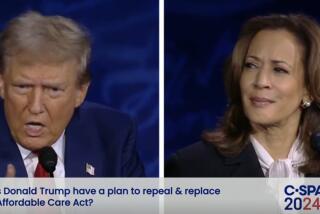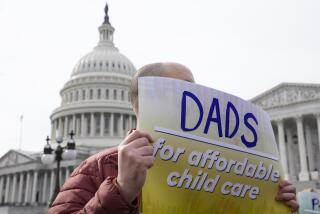Budding Children’s Health Program Could Seed Low-Income Adult Care
- Share via
MORRIS HEIGHTS, N.Y. — Big changes are often measured in small steps. Like the ones that will soon carry 11-year-old Luisanna Padilla from her home in this bustling corner of the Bronx into a hospital for a long-overdue operation.
It’s been five years since Luisanna’s mother, Maria Valdez, first noticed that the girl was suffering from an unusual number of ear infections. Then a teacher observed that Luisanna was having trouble breathing when she spoke in class--and sent home a note saying she might need surgery. But Valdez’s work as a substitute teacher provided neither the income nor the health insurance for an operation--and Luisanna’s condition deteriorated.
About a year ago, Valdez brought her daughter to the Morris Heights Health Center, a South Bronx community clinic. There she learned two things: Luisanna suffered from enlarged adenoids, and she qualified for a New York state program called Child Health Plus that insures the children in working-poor families. Now Luisanna is due to have her adenoids removed next month.
“Ninety-nine times out of 100, she could be perfectly normal after the operation--and she could have been normal for years if the problem had been picked up,” says Dr. Wanda McCoy, the health center’s dynamic vice president. “How much she has lost in school we’ll never know.”
After President Clinton’s effort to provide universal health-care coverage collapsed in 1994, the prospect of helping the 43.4 million Americans without insurance (up from 38.6 million in 1992) has seemed too daunting even to contemplate. Yet Luisanna’s story shows the hollowness in that fatalism. Universal coverage isn’t coming any time soon. But the program that is changing Luisanna’s life could provide a model for incrementally extending coverage to other groups of the uninsured.
New York’s Child Health Plus plan is at the vanguard of a quietly effective initiative that’s showing it is possible to move forward even without a national consensus for systemwide health-care reform. Building on the experience of New York and Vermont--which took first steps with their own money--Clinton and Congress approved a five-year, $24-billion grant program in 1997 to help states insure the children of working-poor families. It was a dramatic attempt to reach children whose parents earn too much to qualify for Medicaid, but are in low-wage jobs that do not carry health insurance.
Now, just 19 months later, the program is taking root with remarkable speed. All but two states (Washington and Wyoming) have appropriated the state dollars they need to access the federal funds. It’s a measure of how broadly the program has been accepted that conservative states such as Alabama and South Carolina are among those moving most aggressively.
Why have so many states signed on? One reason is that the working poor are a constituency both parties want to help (particularly as welfare reform moves more recipients off the rolls and into low-wage jobs). Another is that the federal government agreed to pick up a larger share of the cost for this Children’s Health Insurance Program than it does for Medicaid--the joint state-federal health-care program for the poorest families.
Most important may be the child health program’s unusual design. Congress established a minimum benefit package and limited the fees states could charge. But then the legislation gave the states enormous freedom to design their own programs. “It was the recognition that states, when left to their own devices, can do it better that was so important about the children’s health program,” says New York Republican Gov. George Pataki.
With that flexibility, New York has designed a decentralized program that contracts with private managed care plans to reach the children. In the Bronx, the key has been the Bronx Health Plan, a nonprofit network of community clinics, that’s now treating more than 7,200 kids who before might have seen a doctor only in an emergency room. “Now you have a child who has their own doctor, and who is encouraged to seek preventive care . . . and not just come in when they are sick,” says Maura Bluestone, the health plan’s president.
Around the country, the new children’s health programs are suffering from inevitable growing pains (some states are being criticized for not enrolling eligible children fast enough). But the overall experience has been sufficiently positive that some health experts are now asking whether the states and Washington could adapt the partnership model they’ve built for children to cover more uninsured adults.
Some of the nation’s most innovative governors (including Wisconsin Republican Tommy G. Thompson) have been pressing the federal government to let them use money from the child health program to insure the parents of the newly covered children. Moving away from demands for national health insurance, some prominent liberals now say the federal government should give states grants to cover the uninsured. And in New York, a coalition led by the Greater New York Hospital Assn. is pushing for legislation to cover low-income working adults through a state program modeled on the existing Child Health Plus.
Covering adults can be more complicated than covering children. For one thing, it’s more expensive. Health and Human Services Secretary Donna Shalala points out another hurdle: the risk that a new public program for low-income adults would encourage employers to drop their own coverage. She says legislation to experiment with state block grants for adults might make sense--but so might increased funding for community clinics (like the one in Morris Heights) that already care for those without insurance. “We ought to encourage different ideas,” Shalala says. “I want to plant a lot of different kinds of flowers out there.”
With budget surpluses raining down on Washington and the states, this may be a particularly fertile time for planting seeds. Washington funded the children’s health program in 1997 only after a few innovative states first proved the model could work. Likewise, the best way to revive national interest in reaching uninsured adults may be for a few states, like New York, to first launch their own programs for those workers. In that way, too, even small initial steps could mark the path to big changes.
More to Read
Sign up for Essential California
The most important California stories and recommendations in your inbox every morning.
You may occasionally receive promotional content from the Los Angeles Times.










